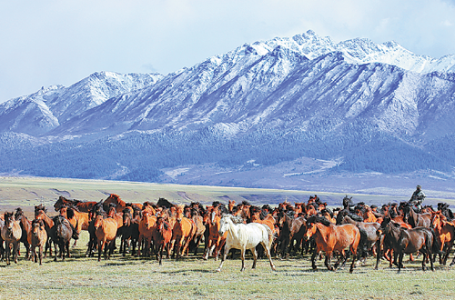Gansu galloping ahead with economic breakthroughs

The Maqu Wetland at Gannan Tibetan autonomous prefecture demonstrates a sound ecological protection effort. [Photo/China Daily]
In terms of education, the province conducted projects to improve 2,886 schools in charge of nine-year compulsory education, benefiting 1.56 million students. It has also built two vocational education colleges.
Focused on driving development by industries, Gansu has accelerated the establishment of a modern industrial system which also helps energize traditional sectors.
Last year, Gansu added 142 new high-tech businesses and designated 234 companies as high-tech innovative ones at provincial level. It had 12 companies listed as national "little giants"-companies that focus on a market niche and master key technologies with a strong innovation capacity and a big market share-by the Ministry of Industry and Information Technology. The province's investment in high-tech manufacturing increased by 39.7 percent.
Moreover, the province deployed the 5G network across its major cities and counties. Social consumption progressed due to the burgeoning development of e-commerce, live commerce and non-contact deliveries. Last year, the amount of online sales increased by 24.8 percent.
With an aim of coordinating the development of urban and rural areas, Gansu has enhanced attention on the rural vitalization and development of new urbanization.
In order to consolidate and expand the achievements made in poverty alleviation, the province helped turn 2,259 workshops used for battling poverty into factories to create more job opportunities in rural areas last year.

Herders move horses at the foot of the Qilian Mountains in Northwest China's Gansu province. [Photo/China Daily]
In the wake of the rural vitalization, the province launched a three-year action plan in 2021, aiming to produce more competitive agriculture. Last year, Gansu welcomed 139 agricultural giants and had six demonstration parks of rural industrial integration development rated at national level. It also launched 61 provincial-level modern agricultural industrial parks.
Located in the upper reaches of the Yellow River in Northwest China, Gansu has been giving ecological and environmental protection priority. The province has signed cooperation agreements with Shaanxi and Qinghai provinces and the Inner Mongolia and Ningxia Hui autonomous regions-which are all along the Yellow River to improve the river environment.
Last year, the government found a total of 4,723 problems in its environmental protection actions, and had 96.8 percent of them fixed. It built 229,000 hectares of forests and completed treatment to more than 141,000 hectares of arid land and 274,000 hectares of grassland.
In response to the goals of peaking carbon emissions before 2030 and achieving carbon neutrality before 2060, Gansu established related mechanisms. Last year, a total of 19 local electric companies entered the national carbon trading market.
In addition, the province has taken an active role in establishing a new development pattern. Efforts have been made in fields including business environment improvement and financial support for the small and medium-sized enterprises, aiming to achieve a higher level of opening-up, according to the provincial government.
-
As AI encounters Dunhuang's art, the ancient caisson ceiling bridges centuries to the present.
View all stories

 Gansu thrives from green development
Gansu thrives from green development  >
>